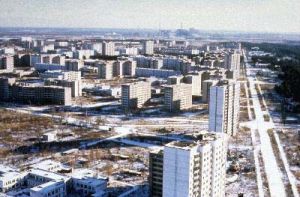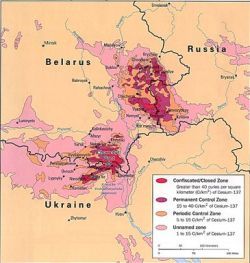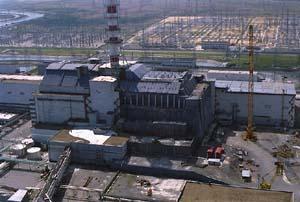II. From Hiroshima and Nagasaki
to the Cold War
III. The Industrial Atom:
Nuclear Energetics and the Cold War
IV. Chernobyl and Beyond
|
To stop the fire and prevent a criticality accident as well as any further substantial release of fission products, boron and sand were dumped on the reactor from the air. In addition, the damaged unit was entombed in a temporary concrete ’sarcophagus,’ to limit further release of radioactive material. http://www.nrc.gov/reading-rm/doc-collec... | Under the normal procedures of the test the reactor would have been reduced to 30% power, but the Soviet electricity authorities refused to allow this because of an apparent need for electricity elsewhere, so the reactor remained at 50% power for another 9 hours, with the safety protocols and computers switched off. http://www.fatherryan.org/nuclearinciden... | The operator forced the reactor up to 7% power by removing all but 6 of the control rods. This was a violation of porcedure and the reactor was never built to operate at such low power. The RBMK reactor is unstable when its core is filled with water. The operator tried to take over the flow of the water which was returning from the turbine manually which is very difficult because small temperature changes can cause large power fluctuations. The operator was not succesful in getting the flow of water corrected and the reactor was getting increasingly unstable. The operator disabled emergency shutdown procedures because a shutdown would abort the test. By that time the operators thought they had the most stable conditions, so they decided to start the test. The operator blocked automatic shutdown on low water level and the loss of both turbines because of a fear that a shutdown would abort the test and they would have to repeat tests. http://www.fatherryan.org/nuclearinciden... | By that time the operators thought they had the most stable conditions, so they decided to start the test. The operator blocked automatic shutdown on low water level and the loss of both turbines because of a fear that a shutdown would abort the test and they would have to repeat tests. Power in the reactor began to gradually rise because of the reduction in water flow caused by the turbine shutdown which lead to an increase in boiling. The operator initiated manual shut down which lead to a quick power increase due to the control rod design. http://www.fatherryan.org/nuclearinciden... | Disaster Point- The reactor reached 120 times its full power. All the radioactive fuel disintegrated, and pressure from all of the excess steam which was supposed to go to the turbines broke every one of the pressure tubes and blew off the entire top shield of the reactor. http://www.fatherryan.org/nuclearinciden... | The Chernobyl accident occurred at the Chernobyl nuclear power plant. It is regarded as the worst accident in the history of nuclear power, producing (due to a lack of a full containment building) a plume of radioactive debris that drifted over parts of the western Soviet Union, Eastern Europe, Scandinavia, UK, and eastern USA. Large areas of Ukraine, Belarus, and Russia were badly contaminated, resulting in the evacuation and resettlement of roughly 200,000 people. About 60% of the radioactive fallout landed in Belarus. http://www.brama.com/news/press/2005/04/... | Immediate results 203 people were hospitalized immediately, of whom 31 died (28 of them died from acute radiation exposure). Most of these were fire and rescue workers trying to bring the accident under control, who were not fully aware of how dangerous the radiation exposure (from the smoke) was http://www.brama.com/news/press/2005/04/... |
|
|
In Sweden, workers at the Forsmark nuclear power plant (approximately 1100 km from the Chernobyl site) were found to have radioactive particles on their clothes. It was Sweden’s search for the source of radioactivity, after they had determined there was no leak at the Swedish plant, that led to the first hint of a serious nuclear problem in the Western Soviet Union. USSR keeps silent. http://www.brama.com/news/press/2005/04/... |
|
Assessing Radiological Consequences. In October 1989, the IAEA coordinated an international study of the accident’s radiiological, environmental and health consequences in selected towns of the most heavily contaminated areas in Belarus, Russia, and Ukraine. Between March 1990 and June 1991, a total of 50 field missions were conducted by 200 experts from 25 countries, seven organizations, and eleven laboratories. http://www.iaea.org/NewsCenter/Features/... | The Chernobyl Shelter Fund (CSF) was set up in 1997 at the EBRD to assist Ukraine in transforming the existing shelter over Chernobyl’s destroyed unit 4 to a stable and environmentally safe state. To achieve this goal, the CSF finances the implementation of the so-called Shelter Implementation Plan which was elaborated by Western and Ukrainian experts in 1997 as a step-by-step solution to the current situation at Chernobyl. http://www.ebrd.com/enviro/nuclear/overv... | ||||
| 1977 -------------------------------------------|----------- |
1986-04-27 ------------------------------------------------|------- |
1986-4-25 02:00 pm ------------------------------------------------|------- |
1986-4-25 1:00-1:20 am ------------------------------------------------|------- |
1986-4-25 01:22 am ------------------------------------------------|------- |
1986-04-25 01:23:44 ------------------------------------------------|------- |
1986-4-26 ------------------------------------------------|------- |
1986-4-26 ------------------------------------------------|------- |
1986-4-27 ------------------------------------------------|------- |
1986-4-27 ------------------------------------------------|------- |
1986-4-27 ------------------------------------------------|------- |
1986-11-1 ------------------------------------------------|------- |
1989-10-1 -------------------------------------------------|----- |
1997 -----------------------------------------------------|- |
II. From Hiroshima and Nagasaki
to the Cold War
III. The Industrial Atom:
Nuclear Energetics and the Cold War
IV. Chernobyl and Beyond



